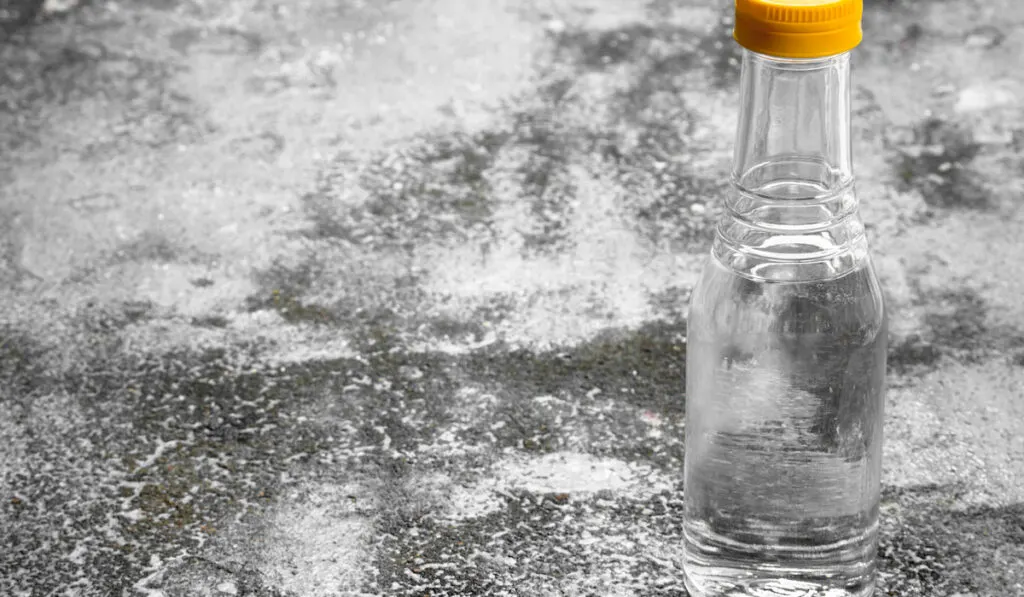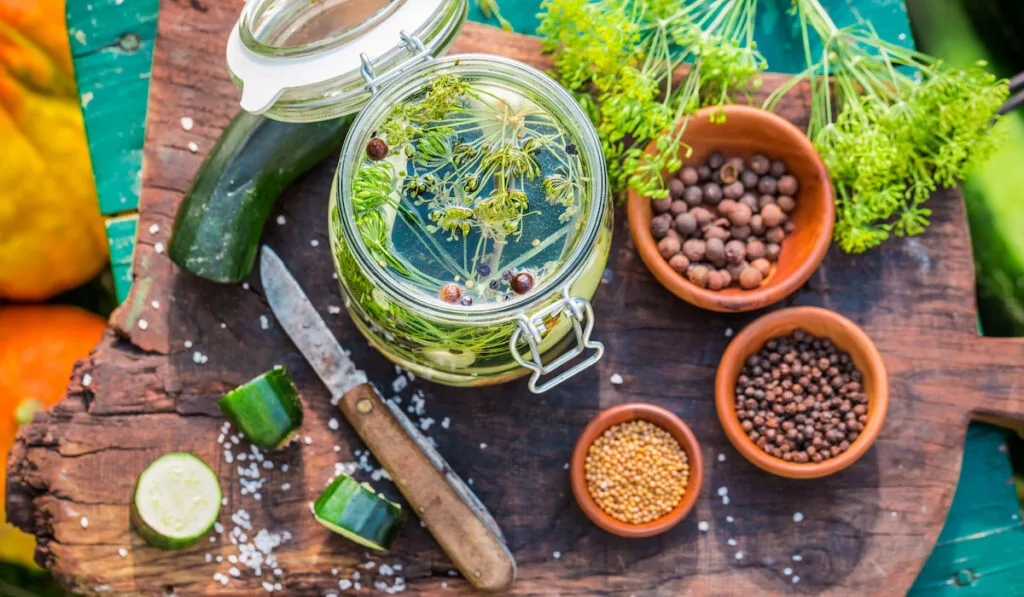Pickling is a timeless food preservation method using vinegar and spices for additional flavor. You can use this method for pickled onions, chutney recipes, and vegetables.
Homemade pickling vinegar is easier to make than you can imagine. Also, since you are at liberty to use only your favorite ingredients, it is better than the store-bought option.
And in the spirit of good manners, it can also be a thoughtful gift to a fellow foodie!

Table of Contents
How Is Pickling Vinegar Different from Regular Vinegar?
By regular vinegar, you mean white vinegar, right? There isn’t much difference. You can actually use the two interchangeably.
Pickling vinegar, however, includes any vinegar used in the pickling process. That means it’s a broader term.
It’s safe to say all white vinegar can be used as pickling vinegar, but the reverse isn’t true.
What Is Pickling Vinegar Made Of?
Pickling vinegar is usually a combination of these four main ingredients:
- Vinegar
- Water
- Sugar
- Salt
We can refer to them as the base ingredients for any pickling vinegar recipe. You can, however, take pickling to a new level by adding herbs and spices as you fancy.
Also, by default, the constituents of pickling vinegar will determine its strength.
The minimum acidity for pickling, which is also accepted as the standard strength, should be 5%.
Which Are the Best Types of Vinegar for Pickling?
As much as there has been a lot of back and forth concerning the best pickling vinegar, it all boils down to the recipe at hand and personal preferences.
White vinegar always comes as a top recommendation for most recipes. However, once people become gurus, they start experimenting with other types, like apple cider. Here is a comparison of the most common types of vinegar used in pickling:
| Vinegar | Pros | Cons |
| Distilled White Vinegar | Preserves color Infuses well with spices | The flavor is not as strong compared to other types of vinegar. |
| Apple Cider Vinegar | Has a balanced acidity Works just as well as white vinegar, so you can use them interchangeably in recipes. | Changes the color of pickled fruits or vegetables. |
| Rice Wine Vinegar | Low acidity Subtle sweetness | Doesn’t have much flavor Can’t be substituted in recipes. |
| Other Wine Vinegar (Can be sourced from champagne, red wine, white wine, or cherry) | High acidity Subtle sweetness Can be infused with other types of vinegar | More costly |
How to Make Pickling Vinegar
Ingredients
- 1 tsp whole cloves
- 1 tsp mustard seeds
- 1 tsp coriander seeds
- 1 tsp black peppercorns
- 1 cinnamon stick
- ½ tsp chili flakes
- 2 bay leaves
- 750ml white wine vinegar
- 100g light brown soft sugar
Equipment
- Wide mouth pint jar with lid
- Saucepan
- Canning funnel (optional)
Prep: Wash the jar and lid in warm, soapy water, rinse well, then set it aside to dry.
Method

- Put all of the whole spices in a saucepan. Toast them over low heat until they release an aromatic smell. Add the dry chili flakes last because they stick to the pan easily. (These ingredients are our selections. You can add or remove some depending on your preferences. However, the spices must be whole, not ground).
- Add the vinegar, sugar, and bay leaves. Let them simmer, and allow the sugar to dissolve.
- Set the mixture aside to allow the spices to infuse further.
- Then pour the mixture into the sterilized jar.
- Store the jar in a cool, dark place until the mixture has fused to your liking. (Anywhere from 2 weeks to 3 months.)
- Strain the spices from the solution. Then you can use your vinegar on all your favorite pickles and chutneys.
Pro Tip: If you need your pickled vinegar to process faster, place the jar on the dishwasher’s top rack for one cycle. It sounds crazy, but it works.
Can I Use Malt Vinegar in a Gluten-Free Recipe?
Malt vinegar is sourced from malted barley, which has gluten. The vinegar can’t be 100% devoid of gluten. However, the concentration is so negligible that you can pass it as gluten-free.
Most kinds of vinegar are distilled and gluten-free. They are made from ingredients like grapes, which are gluten-free. So, if you are looking for gluten-free vinegar, we would advise you to consider these other options instead of malt vinegar.
Pickling vs. Fermenting: What’s the Difference?
These two terms have sparked major confusion for the masses, and it’s justified. Granted, they date back as some of the oldest food preservation methods. There is, however, a thin line separating the two.
Pickling

In pickling, you preserve food by immersing it in an acidic solution. Vinegar is the most commonly used solution here.
Due to the acidic nature of the solution, it’s only obvious that both the taste and texture of the food will change. There’s also some heating involved in the preparation stage to inhibit the growth of bacteria or any other microorganisms.
Fermentation
Fermentation, which is even older than pickling, involves introducing microorganisms like yeast and bacteria to convert carbohydrates into alcohol. This process also happens in the brine, only that this time, there aren’t any acidic ingredients.
Fermentation creates a friendly environment for probiotics to thrive, which means it’s good for your digestive system.
To summarize, the main difference between the two is that you soak the food in an acidic liquid to preserve it when pickling. The acidic solution is responsible for the subsequent sour flavor. Fermented food also has the sour taste, but it is caused by the chemical reactions from the food and the bacteria.

Factors to Consider When Buying Vinegar for Pickling
- The optimal acidity level should be 5%.
- Don’t go for already diluted vinegar.
- Use other ingredients like sugar, salt, or water. Pickling with vinegar alone is a bad idea.
Final Word
Making homemade pickling vinegar is incredibly easy. It’s even healthier because you control the ingredients used, especially if you’re particular about gluten-free foods or vegan recipes.
Resources
We read far and widely before writing this article. Here are the resources used:
